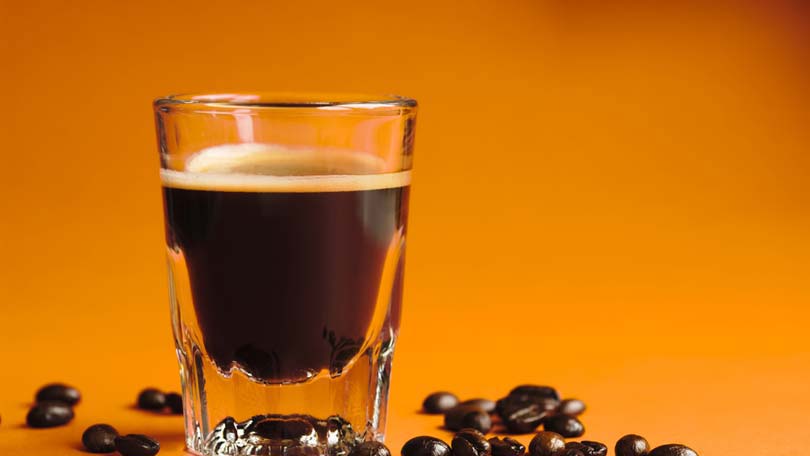
Looking for a way to decrease his worker’s coffee break time, Luigi Bezzera created the very first espresso machine in the early 1900s. Espresso has since undergone a great deal of refinement, and is now a highly coveted drink worldwide. Made by forcing pressurized, heated water through finely ground coffee, espresso contains a higher amount of dissolved liquids than coffee, resulting in richer flavor and higher caffeine content. While the making of a good espresso drink is a complicated process; enjoyment of a good espresso drink is one of life’s simple pleasures.
Developed in Milan, Italy, the first espresso machine was built by Bezzera, the owner of a manufacturing business who decided that making a quicker pot of coffee was the perfect way to increase his employees’ productivity. Bezzera’s patent on this machine was bought in 1905 by Desiderio Pavoni, who thought the bitterness of the steam-produced coffee could be improved. Pavoni began experimenting with different water temperatures and pressures, and decided that the best flavor was produced at a pressure between eight and nine bars, and at a temperature of approximately 195 degrees Fahrenheit. Espresso makers as known today were introduced in 1947 when Gaggia offered the Gaggia Crème Caffe machine for commercial use. It was the first machine to force pressurized water through a bed of coffee that produced consistent results, and was easy to use and affordable for café owners.
Today, espresso is brewed by forcing hot, not boiling, water under high pressure through powdery fine coffee. The process is called “pulling” a shot, which has to do with early machines that had a pull lever to begin the brewing process; today, most machines have a simple button. The ground coffee is packed into a metal filter basket with 7-10 grams of grounds for a single shot, and 12-18 grams for double. The grounds are pressed down to form a firm puck of coffee. Pressurized water is then forced through the coffee in the portafilter which deposits the resulting espresso into a shot glass or demitasse (white porcelain espresso cup). Brewing takes under thirty seconds. The espresso, which is a chemically complex drink and will degrade quickly with heat loss, is to be served immediately at a temperature of 165 degrees Fahrenheit.
Coffeehouses pride themselves on their espresso blends, because making good espresso, even from a programmable machine, can be a challenge due to espresso’s volatile and complex nature. Properly brewed espresso has three parts, the heart, body, and crema (crema is the lighter reddish foam that floats on the surface); when a glass is brewed, all three parts should be seen as three different layers. When consumed, the espresso should have a fine aroma, rich body, and a balanced bitter-sweet taste with a hint of acidity. The espresso flavor and consistency are easily affected by minor problems such as the over or under grinding of beans, over pressing of grounds into the metal filter, and by fluctuation in water temperature. Over and under grinding affect the appearance of crema, as does the firmness of the ground coffee puck in the portafilter. Too much pressure in packing the coffee grounds plus a too-fine grind will cause the pressurized water to stay in the filter too long, resulting in very little crema. If the crema is tan instead of reddish, it may indicate that the grounds are packed too lightly, and the water has run through too quickly. Water that is too cold during brewing can cause sourness, while too hot water can cause bitterness.
A common misconception exists that one type of bean only is used to make espresso. But, espresso is not any certain bean or type of roast; an espresso can be made from the same coffee beans that go into a regular drip machine. The difference is in the grind of the bean as well as the preparation. Companies in the United States such as Starbucks use darker roast beans in espresso drinks, but a medium roast is commonly used in northern Italy.
Packed with flavor and caffeine, espresso lends very well to mixing, and is the base of a variety of coffee drinks. More popular espresso blends are the café latte and the cappuccino, but coffeehouses seem to love creating new drinks. Some lesser known drinks are the affogatto, which is espresso served over ice cream; the Americano, espresso and water in equal parts, sometimes with more water; the black eye, which is a cup of American coffee with two shots of espresso; and the breve, which is espresso in steamed milk and half & half.
Although it took some time for espresso to reach the United States, finally reaching popularity in the 1990s, espresso has since become a beloved drink of coffee enthusiasts. Because it mixes so well with different products, there seems to be an espresso drink to fit anyone’s taste. As more and more coffeehouses pop up all over the country, we can only assume that espresso enjoyment will continue to flourish. After all, in a society devoted to work, espresso, which was originally designed to increase productivity, is quite fitting.
